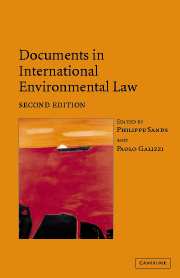Book contents
- Frontmatter
- Contents
- Preface
- PART I General instruments
- PART II Atmosphere
- PART III Oceans: global
- PART IIIB Oceans: regional
- PART IV Freshwater resources
- PART V Biodiversity
- PART VIA Hazardous substances and activities: nuclear
- PART VIB Hazardous substances and activities: pesticides
- PART VIC Hazardous substances and activities: waste
- 28 Convention on the Control of Transboundary Movements of Hazardous Wastes and Their Disposal, 22 March 1989
- 28A Decision III/1 of the Conference of the Parties (Amendment to the Basel Convention), 22 September 1995 (the ‘Basel Ban’)
- 28B Protocol on Liability and Compensation for Damage Resulting from Transboundary Movements of Hazardous Wastes and Their Disposal, 10 December 1999
- 29 Convention on the Ban of the Import into Africa and the Control of Transboundary Movement and Management of Hazardous Wastes within Africa, 29 January 1991
- 30 Code of Practice on the International Transboundary Movement of Radioactive Waste, 21 September 1990
- PART VII Human rights and the environment
- PART VIII War and the environment
- PART IX Trade and the environment
- PART X Environmental impact assessment and access to information
- PART XI Liability for environmental damage and breaches of environmental obligations
- PART XII The Antarctic
28 - Convention on the Control of Transboundary Movements of Hazardous Wastes and Their Disposal, 22 March 1989
Published online by Cambridge University Press: 05 June 2012
- Frontmatter
- Contents
- Preface
- PART I General instruments
- PART II Atmosphere
- PART III Oceans: global
- PART IIIB Oceans: regional
- PART IV Freshwater resources
- PART V Biodiversity
- PART VIA Hazardous substances and activities: nuclear
- PART VIB Hazardous substances and activities: pesticides
- PART VIC Hazardous substances and activities: waste
- 28 Convention on the Control of Transboundary Movements of Hazardous Wastes and Their Disposal, 22 March 1989
- 28A Decision III/1 of the Conference of the Parties (Amendment to the Basel Convention), 22 September 1995 (the ‘Basel Ban’)
- 28B Protocol on Liability and Compensation for Damage Resulting from Transboundary Movements of Hazardous Wastes and Their Disposal, 10 December 1999
- 29 Convention on the Ban of the Import into Africa and the Control of Transboundary Movement and Management of Hazardous Wastes within Africa, 29 January 1991
- 30 Code of Practice on the International Transboundary Movement of Radioactive Waste, 21 September 1990
- PART VII Human rights and the environment
- PART VIII War and the environment
- PART IX Trade and the environment
- PART X Environmental impact assessment and access to information
- PART XI Liability for environmental damage and breaches of environmental obligations
- PART XII The Antarctic
Summary
Editorial note
The Basel Convention on the Control of Transboundary Movements of Hazardous Wastes and their Disposal regulates the transport and disposal of hazardous and other wastes and seeks to make such transport a matter of public record. The ultimate goal of the Convention is to protect human health and the environment from the dangers of such wastes, in application of the principle that wastes should be disposed of in the State where they were generated. The Convention is premised upon the belief that by requiring the generator to carry out duties regarding transport and disposal of the wastes, the amount of waste generated will be reduced.
The Convention restates the right of every State to ban the entry or disposal of foreign hazardous wastes in its territory (Article 4(1)). For purposes of the Convention wastes are defined as hazardous either by reference to categories set out in Annex I, unless they do not possess the characteristics listed in Annex III, or if so classified by national legislation (Article 1). Many of the Convention's obligations also apply to ‘other wastes’ listed in Annex II, which encompasses household wastes or residue from incineration from household wastes (Article 1). Excluded from the Convention's ambit are radioactive wastes and wastes discharged from the normal operation of ships so long as they are regulated by other international instruments (Article 1).
- Type
- Chapter
- Information
- Documents in International Environmental Law , pp. 879 - 914Publisher: Cambridge University PressPrint publication year: 2004
- 1
- Cited by



